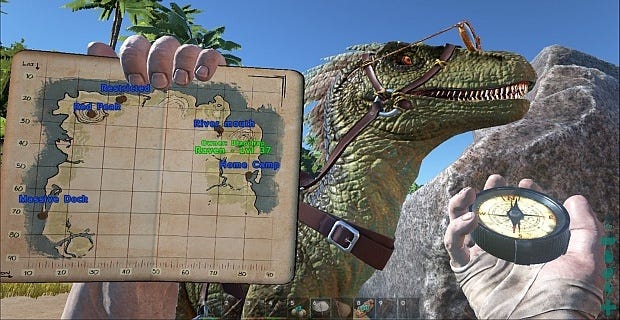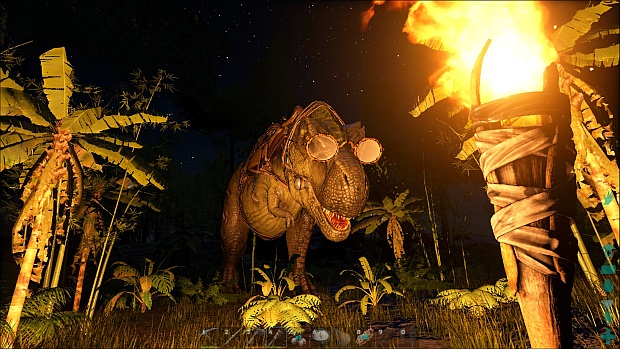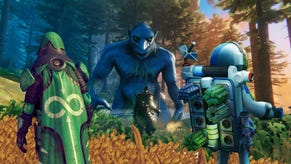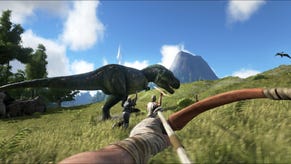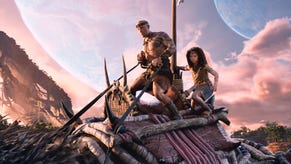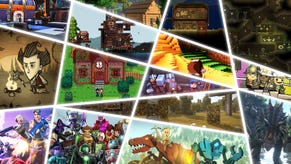An Anthropological Jaunt Through Ark: Survival Evolved
A tree fell in the distance, lumberjack style, and I knew I would have to investigate. A second tree fell as I approached, then a third. By the time the man in red armour turned and saw me, I had already resolved to die in whatever mundane or horrible fashion he deemed appropriate. Hours of DayZ and Rust had instilled in me an understanding of survival gaming’s harsh realities. Yet, for some reason, all that time spent respawning had never eroded my essential curiousity for the human beings who inhabit these deadly environments. I said hello to the man in red. He held his axe aloft for a moment and stood eerily still. “Hello,” he said. Then he did something entirely unexpected. He took me into his home.
Ark: Survival Evolved [official site] has been straddling the Steam bestsellers list for months since its release. Like the many survival games before it, the dinosaur infested island of Ark has been attracting PC gamers non-stop, as if they really were arriving to its pristine beaches by the boatload. And yet the response of the games media, outside of the YouTube dimension, has been kind of muted. You can understand why. It is another survival game.
But to ignore its popularity completely would be doing a disservice to the phenomenon. With this is mind, I have been tasked with exploring “The Island” and answering the question on everybody’s mind: Just who is playing this game? Is it the Rust crowd, graduating from mutated bears to megalodons? Or is it the Minecraft tribe, lusting for a world of lush, unsquare ferns? Perhaps it is a new conglomeration of peoples. We can only find out by talking to them. Which is how I found myself within the high-walled compound of the Nanaki tribe, staring down the barrel of a rudimentary single-shot rifle.
I backed off a step or two and the man in black armour lowered his gun. He was living with the man in red, who had taken me a few hundred yards from where he was chopping trees into a dino compound with a massive metal gate. Now I was alone with compound’s tamed animals and Red’s ornery tribemate, whom I expected at any moment to shoot me in the back of the head and strip me of my clothes and tools. Instead, he hopped onto the back of a Tyrannosaurus Rex and stomped around inside the compound. It is possible this was a show of strength.
When Red returned, he beckoned me to follow him to a corner of the camp. Standing fiercely by the tall wooden walls was a ferocious man-sized carnivore.
“You see this dinosaur?” said Red.
I looked at the razor-filled jaws.
“You see this raptor?”
He was going to feed me to the raptor.
“Well,” he said. “It’s yours.”
I knew it. I just knew… wait, what?
“You take it. Let me just unclaim it. There you go.”
I approached the dinosaur. On closer inspection, it was wearing glasses. Through a menu I claimed him for my own. His name, I discovered, was Raven. And just like that I owned one of the fastest animals in the game, and all without the necessary levelling up. Normally, it would take a thirty minute or hour-long taming ritual to attain this creature, feeding it endless raw steaks while also keeping it sedate with narcoberries or judicious punches to the head. Not for me, though. Luck and generosity had bestowed me Raven without having to endure the game’s most-disliked time sink (taming a Brontosaurus, for example, can take 4-6 hours, according to the wiki but this may have since been patched).
“Is there anything I can do?” I asked, guffawing at the Nanaki tribe’s hospitality. It was okay, said Red. Take him for a ride. Then on my way out, he called me back.
“Actually,” he said, “if you wanted to help you could collect some wood for us?”
And so began my brief stint as the Nanaki’s lumberjack. I collected wood and brought it back using Raven as a pack mule. I set up a cabin close to the compound, shrouded by rocks and trees, and placed a wooden crate outside it operating under the honour system. I set up standing torches, so that I could always find my home, hidden as it was in the brush nearby. Life was good, beside the Nanaki.
But one tribe does not an island make. There were others working the land, I had seen buildings dotted around on my forays into the overgrowth. Certainly, I had fallen in with a nice crowd. But what were the other tribes like? I had seen them nattering in the chat window and it all seemed innocuous enough, even friendly. Yet to meet them face-to-face was the real test. One day, I marked my home with a pin on my map, loaded Raven up, and without saying anything to Red or Black, I departed for a journey around the island.
Day One
I met a woman called Camillaheha, of the tribe Fantasia. She was feeding one of her tribes’ triceratops when I approached and showed no distress when she noticed Raven and I standing a few metres away. The wooden lodge her tribe had constructed on the beach in the Northeast was a homely place. I asked if she would mind taking a self-portrait (or “selfie”) with me and she was more than happy to oblige.
She welcomed me into her home, where I was shocked to find two male bodies slumped on the floor. For a moment I was worried. It seemed to have taken only a single day to discover the psychopathic personality type that so often inhabit survival games, enticing people into their houses, then murdering them. But my concern was misplaced.
“That’s what happens,” she told me, “when you log out.”
This is one of Ark’s tricks. Like Rust, your body has permanence in the environment. Even when you quit, you are still in the game, sleeping. So you have to make sure you are in a safe place before you log off to enjoy your Chicken Korma or whatever it is you eat.
On the one hand, I dislike features like this in games because they are a method of hijacking more time from the player than is necessarily desirable to give. Like a Facebook game, mugging you slice by slice of your time because of some decaying crops. On the other hand, it does fit the idea of surviving. After all, if you lived on an island populated with dangerous prehistoric creatures, you would probably not sleep under the stars every night, no matter how romantic it was.
Camillaheha steps over the bodies of her tribemates. When I go to leave she sends me on my way in the most neighbourly way imaginable: by giving me lots of presents. One of these is the blueprint to a compass, which I quickly craft and treasure for the rest of my trip. I add Fantasia to my mental list of friendly tribes.
Day Two
I found Bonny lying in the sun, stripped to her undies. I looked around for help, or for any sign of a house that might be hers, but to no avail. I dismounted Raven and tried to help. It was only when I was dragging Bonny’s unconscious body into the shade of some nearby trees that I realised how suspect this scene would look to an outsider, were anyone to encounter us at that exact moment. I stopped for a moment to consider the situation, then continued dragging her into the woods.
I didn’t know how to revive her, if she had not simply logged off. Her ‘Torpidity’ (the game’s meter for determining how close you are to passing out from heat, poison, blood loss or other effects) seemed to be completely full and judging by her health bar, she had been hurt somehow. I fashioned a thatch hut out of the plants and trees nearby and placed her inside. It would not protect against a determined player with an axe but perhaps it would keep her cool and out of sight of angry dinos. I left a box inside the cabin with a note, explaining her circumstances, then left. I hope Bonny is OK.
Day Four
Today I climbed to the summit of a mountain I have named ‘Red Peak’. It houses one of Ark’s three mysterious pillars - floating structures that rise into the sky with a beam of coloured light. These creations, being so alien and stark against the natural beauty of the world, bring Halo’s forerunner buildings to mind (in fact, the game’s subtitle “Survival Evolved” has a certain Halo musk to it too, don’t you think?).
I have learned that the base of the pillars are used to summon the Broodmother, a mythical creature that requires automated machine guns or many fearsomely equipped warriors to defeat. The requirements for this ritual are extensive (a warrior must retrieve six artifacts from various caves and several trophies from dangerous dinosaurs). The prize for defeating the fiend is nothing but respect. Warriors who are successful receive only a cloth flag with a symbol of the beast painted on in dye. It is not known if all the tribes of the island adhere to this ritual.
While inspecting the structure and taking some rock samples (the stone here is metal-rich) I am unnerved to see a disproportionately wide-shouldered man approach, riding a 15-foot tall carnosaur. He dismounts and we approach each other. His name is ‘i love you’.
It is unclear if all the members of his tribe, the Empire, are equally misshapen. But my own character, Blapchap, is also channelling Quasimodo (an effect of the game’s invitingly extremist character creator). i love you must appreciate our kindred physiques because, despite his strange demeanor, he is as non-aggressive as any of the other natives I have encountered. I ask him if he wants to be in a selfie.
“Uhhh, maybe later.”
He mounts his carnosaur (named Padawan) and disappears. I begin to take some notes about the encounter when he suddenly returns, his dinosaur rumbling up to me in a ferocious manner. I look up, expecting to be devoured. Suddenly, he stops, inches from my face.
“Do you want a better pickaxe?”
He is shouting down from his saddle.
“Uhh, if you have one spare, sure!”
He throws down a box with a metal pick inside and some surplus stone for good measure, then tells me he is off to meet a friend.
“Goodbye!”
Just when I think I have met a man rude enough to kill me, he turns around and gives me gifts. Ark, you are a strange survival game.
Day Six
I have reached the southwest of the island, where a gigantic wooden gatehouse looms over an idyllic inlet. It looks like a huge shipyard, and it is definitely the largest human-made building I have seen in the game. I can only imagine what creatures it houses. Halfway across a wooden bridge to the mainland (impressive in its own right) I met a man called Arggggggg. Like me, he rode a raptor. But unlike me, his body armour was darkest plate instead of basic cloth. I asked him if he was the one working on the bridge.
“Yes,” he said, “but there is a lot of work to go.”
He told me that he and three others in his tribe, Overlord, had built the giant gatehouse and that it was just the beginning of a project to make a dock of the inlet, so that they could capture and train sea animals. I praised their fortitude. Something so big could take a long time.
“Yes,” he said, “but you have to work in groups. Otherwise, it’s impossible.”
Arggggggg, in his expertise, had brought up an undeniable truth of the game. Buildings like the one he and the rest of Overlord had constructed were certainly impossible without teamwork. But even smaller structures are a difficult proposition without help. A basic wood cabin will take under an hour, if you start with nothing. But creations beyond that take so much time and effort, not counting the collection of food and water to keep you going through the hard work, that it really does force you to seek aid. As annoying as this may be to the average player with a lone wolf mindset, it is maybe one of the reasons there seems to be a lot less murder happening. People feel inclined to be neighbourly, at least to each others faces, simply because resource gathering is burning up most of their calories. In Ark, you simply do not have the time to be an asshole.
I hop back on Raven and say goodbye to Arggggggg.
“When you need help,” he says, “come back and see us.”
Day Seven
I scooted round the southern coast today, where there were many small individual huts and shacks. Many of them seemed abandoned. This is not too much of a surprise - the perceived wisdom of The Island insists that the South is more tame and less dangerous than the North, which is why many new players will start out there before they move inland.
I saw one man on my way though, waddling along on the back of a grumpy Ankylosaurus, which was smashing up rocks in a workmanlike silence. He was not talkative when I spoke to him. But he was not aggressive either. Perhaps most tellingly, he was not afraid. He just carried on doing what he was doing, as if I was not even there. My feeling that Ark is an environment with far less person-on-person violence than its contemporaries continues to grow. Unlike Rust, the default expectation I have found so far is that you will not be attacked.
Then again, I may just be getting lucky. Even one or two of the players I have stumbled across on my trip have admitted that there were “bad people” on the server. But if there are, I am not finding any of them. I feel perhaps the crime of “bad” players in Ark is more like petty crime, or vandalism. Things will be demolished, or go missing while you are logged off. But as for in-the-moment PvP, there just doesn’t seem to be any appetite for it.
Partially, this must come down to the time investment. If it takes the Nanaki and some buddies two hours to tame a Mammoth, they are not going to risk it in a brawl with some other faraway tribe over some resources they may or may not want. That, and the resources themselves are so plentiful it’s hilarious. It is a virgin land, with more trees, shrubs, berries and dinos than you could ever want. This also means that the futuristic supply crates which periodically beam down to the island are of limited value. They contain scraps, helpful only in small ways. There is no rush for them, no wild and violent scramble, like there is in Rust. Then again, is this a bad thing? Isn’t there a place for a survival game with a bit more natural friendliness?
In the chat window, people from different tribes talk back and forth. This window also serves as a kind of “lost and found”, as pets and tamed animals regularly wander off, chasing something, or go missing without warning.
“Anyone lose a ptera?” one player asks. “called razor. from the flintstones tribe.”
I feed Raven some raw Dodo meat and we speed off, along the beach.
Day Nine
I have finally made it back to the familiar lands of the East coast. I recognise the peninsula near the Nanaki settlement but in my absence one of the giant neighbouring pens has decayed or been demolished. This reveals one of the survivor’s real issues. People may not be nasty to you in person, but if you leave your building for long enough without logging in, anyone is allowed to demolish it, piece by piece, with the simple click of a button.
The Nanaki’s compound, luckily, is still intact. It even has a new sky pen for the tribe’s pteradons. But night is closing in and the torches I once lit to help me find my hidden lumber cabin have long gone out. I fumble around in the overgrowth with my torch until it is darker than the inside of an old boot. Animal noises come from the jungle, the leaves rustle with the wind. I am beginning to worry if griefers have demolished my home.
I have an idea. If I craft a sleeping bag and put it down here, I can use it to see where to go. You see, as well as acting as a spawn point, all your sleeping bags in Ark are mysteriously linked and allow you to fast travel between them. So when you use one, you get a map of where the others are. I can use this to find my cabin! I finish up crafting the hide bag and take a look at the map. As it turns out, I’m not far away at all. It is somewhere nearby, maybe only a few hundred metres away. Maybe --
stomp
What was that?
stomp stomp stomp
I can hear growling.
STOMP.
Yes that is definitely carnivorous growling.
STOMP STOMP STOMP STOMP STOMP.
I scramble to leave the map screen just as a terrifying Tyrannosaur roars in my face. This is it. This is the end. I can’t believe I made it all the way back only to die two hundred yards from my door. I turn to the beast, hoping that he will only kill me and that Raven (beautiful Raven) will have the sense not to attack. I look up at the T Rex.
It is wearing glasses.
“Hello there!”
A man on the back of the T Rex peers down at me in the torchlight. He dismounts. It is a one of the Nanaki.
“Need help?”
I swear at him and breathe a quick sigh of relief, and then tell him about my troubles. I tell him I’ve just been around the island, but that his tribe have helped me in the past. I tell him they gave me this raptor. This precious raptor of mine.
“Oh! So they did!” he says, delighted. “Hello, Raven.”
And I tell him I’m lost. My cabin is around here somewhere but I can’t remember exactly where. Without asking anymore questions he says “follow me!” and dashes into the jungle. I follow him swiftly and within 60 seconds he has led me straight to the threshold of my old cabin. It is completely intact.
“Is this it?”
I laugh. It is the second time the Nanaki have helped me out, for no other reason than being good neighbours. I thank him and he dashes back of into the night with a “no problem” that seems to sum up the entirety of my time in Ark. Inside the cabin, all my gear is still there. No problem. The campfire outside it still working. No problem. Raven is settling in beside the flames. No problem.
Life is good, beside the Nanaki.
